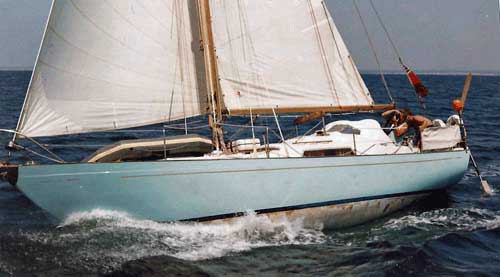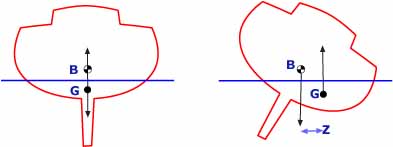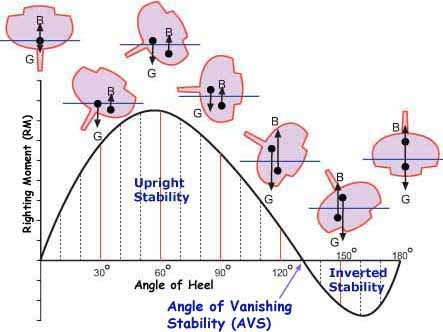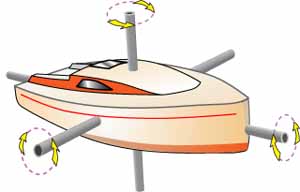Sailboat Design: A Guide to Stability, Buoyancy & Performance
In a Nutshell
Understanding how a sailboat achieves stability, buoyancy, and performance is key for any sailor.
- Stability is a boat’s resistance to heeling and capsizing, driven by the relationship between its center of gravity (G) and center of buoyancy (B).
- Buoyancy is the upward force that keeps the boat afloat, directly related to the volume of water it displaces.
- Performance is a measure of how efficiently a boat sails, influenced by factors like displacement, hull shape, and sail area. Modern design trends favor wider, lighter hulls for greater speed and initial stability, while traditional designs often rely on heavy displacement for a more comfortable motion and ultimate stability in offshore conditions.
A balance of these elements is crucial for creating a seaworthy, safe, and enjoyable boat.
 I know how stable this Nicholson 32 Mk10 is. She's called Jalingo II—and she used to be mine...
I know how stable this Nicholson 32 Mk10 is. She's called Jalingo II—and she used to be mine...Table of Contents
How is a Sailboat's Stability Created & Sustained?
Being something of an "Old Salt", I've seen firsthand that a boat's stability is the single most important factor for comfort and safety at sea. Stability is the ability of a boat to resist heeling (leaning over) and to right itself after being pushed by wind or waves.
A boat's stability is determined by the interplay between its Centre of Gravity (G) and its Centre of Buoyancy (B).
- Centre of Gravity (G): This is the single point where the boat’s entire weight is considered to be concentrated. A lower Centre of Gravity (G) improves stability. This is why ballast, which is heavy weight, is placed low in the keel.
- Centre of Buoyancy (B): This is the centre of the volume of water the boat displaces. The buoyant force acts upward through this point, pushing the boat up.
 Relationship between the Righting Moment (Z), Centre of Gravity (G) and Centre of Buoyancy (B)
Relationship between the Righting Moment (Z), Centre of Gravity (G) and Centre of Buoyancy (B)As the boat heels, the hull's shape changes the submerged volume, causing the Centre of Buoyancy (B) to shift outboard. This creates a "righting moment," which is the force that acts to push the boat upright. The greater the horizontal distance between the Centre of Gravity (G) and the Centre of Buoyancy (B), the greater the righting moment, and the more resistant the boat is to further heeling.
 The all-important 'Angle of Vanishing Stability'
The all-important 'Angle of Vanishing Stability'This relationship is best shown by a Gz Curve, which plots Righting Moment against the Angle of Heel. A boat's Angle of Vanishing Stability (AVS) is the point on this curve where the righting moment becomes zero, meaning the boat has lost its ability to right itself and will capsize. This is a critical factor in a sailboat's classification into one of the four recognised design categories: Ocean, Offshore, Inland, and Sheltered Waters.
How Do Hull Shape & Displacement Influence Stability?
The hull's shape and its displacement play a crucial role in its stability.
- Form Stability: This refers to the stability a boat gains from its hull shape, particularly its beam (width). A wider, flatter hull has greater initial stability, resisting the first degrees of heel more effectively. Modern cruising yachts often have wide sterns and plumb bows to maximize this type of stability and increase interior volume.
- Ballast Stability: This is the stability derived from the weight of ballast, typically a heavy keel. A heavy, deep keel lowers the Centre of Gravity (G), increasing the righting moment as the boat heels. This is crucial for a boat's ultimate stability.
Heavier displacement boats with their weight concentrated low down, generally have a more comfortable motion in a seaway. In contrast, lighter displacement boats often have a quicker, more jerky motion. Designers must carefully balance these two types of stability to create a boat that is both safe and comfortable for its intended use. For example, my previous sailboat, Alacazam, uses a water ballast system as a way to adjust her stability and optimise her performance for different conditions.
What are a Sailboat's Three Axes of Rotation & Why Do They Matter?
A sailboat's motion through the water is a complex dance of forces, and a key part of understanding stability and comfort is recognising the three rotational axes around which it moves. Your boat is constantly rotating around these three central axes, which are all perpendicular to one another.
- Roll: This is the side-to-side rotation around the longitudinal axis that runs from the bow to the stern. This is the most significant motion for a sailboat, as it is directly opposed by the boat's stability. A boat with a slow, comfortable roll is often preferred by cruising sailors, as it indicates a good balance between form and ballast stability.
- Pitch: This is the fore and aft, or up and down, rotation around the transverse axis that runs from side to side. Pitching is the nodding motion a boat makes as it rides over waves. A long, slender hull will pitch less abruptly than a short, wide one, contributing to a more comfortable ride in a seaway.
- Yaw: This is the rotation around the vertical axis that runs from top to bottom. Yaw is the boat’s motion of swinging the bow from side to side. While some yaw is unavoidable, excessive yawing can be a sign of poor directional stability, making the boat harder to steer and track a straight course.
 Roll, Pitch & Yaw
Roll, Pitch & YawUnderstanding and managing these motions is fundamental to a sailor’s comfort, safety, and control of their vessel in varying sea conditions.
What Are the Key Drivers of Sailing Performance?
The performance of a sailboat is a balancing act of multiple design factors. The most important drivers are:
- Displacement & Wetted Surface: A lighter displacement boat generally has a higher power-to-weight ratio and less wetted surface (the area of the hull in contact with the water), which reduces drag and allows for greater speed.
- Hull Shape: A slim, arrow-like hull offers less resistance than a squat one. However, designers must balance this with the need for internal volume and stability.
- Sail Area: The amount of sail a boat can carry is a primary driver of speed. A larger sail area provides more power from the wind. This is often balanced against the boat's stability, as a powerful sail plan requires a stable platform to avoid excessive heeling.
The relationship between these factors is expressed through various sailboat design ratios, which you can learn more about in our article: "Mastering Sailboat Design Ratios & Regulation for Performance & Safety".
This article was written by Dick McClary, RYA Yachtmaster and author of the RYA publications 'Offshore Sailing' and 'Fishing Afloat', member of The Yachting Journalists Association (YJA), and erstwhile member of the Ocean Cruising Club (OCC).
Common Questions & Answers about Sailboat Design
What is the difference between a 'stiff' and a 'tender' boat?
What is the difference between a 'stiff' and a 'tender' boat?
A stiff boat has high initial stability and resists heeling. A tender boat has less initial stability and heels easily. Stiff boats feel more stable initially but can have a quick, jerky motion, whereas tender boats may heel more but often have a more comfortable roll period.
Why do modern boats have wide sterns?
Why do modern boats have wide sterns?
Modern boats have wide sterns to increase form stability, which makes the boat more resistant to heeling. This design also increases interior volume for accommodation and provides a larger platform for modern twin rudders.
Does more ballast always mean a safer boat?
Does more ballast always mean a safer boat?
Not necessarily. While a lower Centre of Gravity (G) created by ballast is essential for ultimate stability, a boat with too much ballast for its design can be sluggish and lose sailing performance. The balance between a boat’s form and ballast is what really counts for safety.
Why is a boat's Angle of Vanishing Stability (AVS) important?
Why is a boat's Angle of Vanishing Stability (AVS) important?
The AVS is a critical safety measure as it indicates the angle of heel at which a boat will no longer be able to right itself. An AVS of over 120 degrees is generally considered ideal for serious offshore or ocean sailing.
Sources Used
- "MODERN SAILBOAT DESIGN: Form Stability." Wave Train. https://wavetrain.net/2013/03/22/modern-sailboat-design-form-stability/
- "Stability, Buoyancy & Performance." Fontaine Design Group. https://www.fontainedesigngroup.com/about-us/stability/
- "How hull shape affects comfort at sea." Yachting Monthly. https://www.yachtingmonthly.com/sailing-skills/how-hull-shape-affects-comfort-at-sea-79794
- "How to Choose a Safe Cruising Sailboat." YachtWorld. https://www.yachtworld.com/research/choose-safe-cruising-sailboat/
- "Yacht Stability: Considerations for Safety and Sea Worthiness." YBAA. https://ybaa.yachts/aws/YBAA/pt/sd/news_article/522600/_PARENT/layout_details/false
- "Understanding your boat and her statistics." Yachting Monthly. https://www.yachtingmonthly.com/yacht-reviews/understand-boat-statistics-30154
Recent Articles
-
Marine Water Heating Systems: Free Hot Water from Your Boat's Engine
Dec 03, 25 05:06 PM
Tap into your engine's heat to get free hot water on board. An experienced ocean sailor's guide to marine water heating systems, calorifiers & safety. -
Marine Watermakers: An Offshore Sailor’s Guide & Practical Tips
Dec 03, 25 04:31 AM
Boost your yacht's range with Marine Watermakers. A Yachtmaster's guide to choosing, installing, and maintaining reverse osmosis desalinators for reliable, fresh water on long passages. -
Optimising Your 12-Volt Boat Fridge for Offshore Sailing & Efficiency
Dec 01, 25 11:05 AM
Master your 12-Volt Boat Fridge system. A guide for experienced sailors covering mechanics, installation, troubleshooting, and advanced electrical efficiency on extended voyages.












